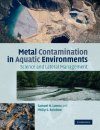By: Samuel Luoma and Philip S Rainbow
573 pages, 137 line figures, 31 halftones, tabs
![Metal Contamination in Aquatic Environments Metal Contamination in Aquatic Environments]()
Click to have a closer look
About this book
Contents
Customer reviews
Biography
Related titles
About this book
Metal contamination is one of the most ubiquitous, persistent
and complex environmental issues, encompassing legacies of the past (e.g. abandoned mines) as well as impending, but poorly studied, threats (e.g. metallo-nanomaterials). Writing for graduate students, risk assessors and environmental managers, Drs Luoma and Rainbow explain why controversies exist in managing metal contamination and highlight opportunities for policy solutions stemming from the latest advances in the field. They illustrate how the 'lateral' approach offers opportunities in both science and management, making the case that the advanced state of the science now allows bridging of traditional boundaries in the field (e.g. between field observations and laboratory toxicology).
The book has a uniquely international and interdisciplinary perspective, integrating geochemistry, biology, ecology, and toxicology, as well as policy and science. It explicitly shows how science ties into today's regulatory structure, identifying opportunities for more effective risk management in the future.
Contents
1. Introduction; 2. Conceptual underpinnings: science and management; 3. Historical and disciplinary context; 4. Sources and cycles of trace metals; 5. Concentrations and speciation of metals in natural waters; 6. Trace metals in suspended particulates and sediments: concentrations and geochemistry; 7. Trace metal bioaccumulation; 8. Biomonitors; 9. Manifestation of the toxic effects of trace metals: the biological perspective; 10. Toxicity testing; 11. Manifestation of metal effects in nature; 12. Mining and metal contamination: science, controversies and policies; 13. Selenium: dietary exposure, trophic transfer and food web effects; 14. Organometals: tributyl tin and methyl mercury; 15. Hazard rankings and water quality guidelines; 16. Sediment quality guidelines; 17. Harmonizing approaches to managing metal contamination: integrative and weight of evidence approaches; 18. Conclusions: science and policy.
Customer Reviews
Biography
Sam Luoma was a research scientist at the U.S. Geological Survey for 34 years, before moving to the University of California at Davis. He was the first Lead Scientist for California's redesign of water management, gaining valuable experience in linking science and policy. He was a W. J. Fulbright Distinguished Scholar in 2004 and was awarded the U.S. Presidential Rank Award for career accomplishments in 2005. Phil Rainbow is Keeper of Zoology at The Natural History Museum in London, managing both public communication of science and a staff of more than 100 working scientists in one of the premier scientific institutions in the world. He was awarded the annual Kenneth Mellanby Review Lecture Prize by the journal Environmental Pollution in 2002.
By: Samuel Luoma and Philip S Rainbow
573 pages, 137 line figures, 31 halftones, tabs
Review of the hardback: 'This book will become required reading for aquatic science students, practising environmental scientists and environmental managers and even some policy makers and I commend it to those groups.' Mike Elliott, Institute of Estuarine and Coastal Studies, University of Hull Review of the hardback: 'The book ... is excellent... The material ... is well ordered and logical. ... one of the most pleasing aspects of the book is that it has a truly international focus, rather than the usual American or European focus... The reference list is very extensive and more importantly, comprehensive and representative ... The language is direct and clear... Historical context to the evolution of concepts is also regularly provided by referring to seminal papers and these are also very useful and insightful... The illustrations are first-class. ... it will be in the 'constantly referred to' part of my bookcase ... will I recommend the book to others? Yes indeed.' Michael Warne, Commonwealth Scientific and Industrial Research Organisation Review of the hardback: 'There are so many things to like about this book; I hardly know where to start. It can serve as an authoritative reference for anyone involved with the environmental chemistry or toxicology of metals in aquatic ecosystems. ... it would serve as an excellent advanced text. ... I am glad to have this book and expect to refer to it often. In particular, I plan to use it as a guide to updating the metals module in the CADDIS website.' Integrated Environmental Assessment and Management




































